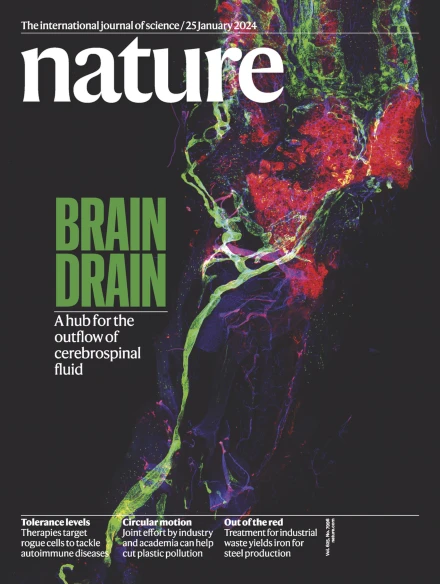B 细胞与肉瘤患者的存活率和免疫疗法反应有关
IF 50.5
1区 综合性期刊
Q1 MULTIDISCIPLINARY SCIENCES
引用次数: 986
摘要
软组织肉瘤是一种异质性癌症,有 50 多种组织学亚型1,2。不同亚型患者的临床表现往往不典型,对免疫检查点阻断等疗法的反应也大相径庭3,4。为了解释这种临床变异性,我们在此研究了 608 例软组织肉瘤亚型肿瘤的基因表达谱。我们根据肿瘤微环境的组成建立了基于免疫的分类,并确定了五种不同的表型:免疫低(A 和 B)、免疫高(D 和 E)和高血管化(C)组。对独立验证组群的原位分析表明,E 组的特点是存在三级淋巴结构,其中含有 T 细胞和滤泡树突状细胞,B 细胞尤其丰富。即使在 CD8+ T 细胞和细胞毒性含量较高或较低的情况下,B 细胞也是最强的预后因素。在一项二期临床试验中,E类组用pembrolizumab阻断PD1后,生存率提高,应答率也很高。总之,这项工作证实了软组织肉瘤患者的免疫亚型,并揭示了富含B细胞的三级淋巴结构在指导临床决策和治疗方面的潜力,这可能会在其他疾病中得到更广泛的应用。对软组织肉瘤的肿瘤微环境进行免疫分析,发现了一组具有高水平B细胞浸润和三级淋巴结构的患者,他们的生存率提高了,对免疫检查点阻断疗法的反应率也很高。本文章由计算机程序翻译,如有差异,请以英文原文为准。

B cells are associated with survival and immunotherapy response in sarcoma
Soft-tissue sarcomas represent a heterogeneous group of cancer, with more than 50 histological subtypes1,2. The clinical presentation of patients with different subtypes is often atypical, and responses to therapies such as immune checkpoint blockade vary widely3,4. To explain this clinical variability, here we study gene expression profiles in 608 tumours across subtypes of soft-tissue sarcoma. We establish an immune-based classification on the basis of the composition of the tumour microenvironment and identify five distinct phenotypes: immune-low (A and B), immune-high (D and E), and highly vascularized (C) groups. In situ analysis of an independent validation cohort shows that class E was characterized by the presence of tertiary lymphoid structures that contain T cells and follicular dendritic cells and are particularly rich in B cells. B cells are the strongest prognostic factor even in the context of high or low CD8+ T cells and cytotoxic contents. The class-E group demonstrated improved survival and a high response rate to PD1 blockade with pembrolizumab in a phase 2 clinical trial. Together, this work confirms the immune subtypes in patients with soft-tissue sarcoma, and unravels the potential of B-cell-rich tertiary lymphoid structures to guide clinical decision-making and treatments, which could have broader applications in other diseases. Immune profiling of the tumour microenvironment of soft-tissue sarcoma identifies a group of patients with high levels of B-cell infiltration and tertiary lymphoid structures that have improved survival and a high response rate to immune checkpoint blockade therapy.
求助全文
通过发布文献求助,成功后即可免费获取论文全文。
去求助
来源期刊

Nature
综合性期刊-综合性期刊
CiteScore
90.00
自引率
1.20%
发文量
3652
审稿时长
3 months
期刊介绍:
Nature is a prestigious international journal that publishes peer-reviewed research in various scientific and technological fields. The selection of articles is based on criteria such as originality, importance, interdisciplinary relevance, timeliness, accessibility, elegance, and surprising conclusions. In addition to showcasing significant scientific advances, Nature delivers rapid, authoritative, insightful news, and interpretation of current and upcoming trends impacting science, scientists, and the broader public. The journal serves a dual purpose: firstly, to promptly share noteworthy scientific advances and foster discussions among scientists, and secondly, to ensure the swift dissemination of scientific results globally, emphasizing their significance for knowledge, culture, and daily life.
 求助内容:
求助内容: 应助结果提醒方式:
应助结果提醒方式:


